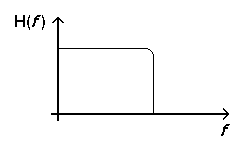| << Chapter < Page | Chapter >> Page > |
When designing digital filters for signal processing applications one is often interested in creating objects in order to alter some of the properties of a given vector (where ). Often the properties of that we are interested in changing lie in the frequency domain, with being the frequency domain representation of given by
where and are the amplitude and phase components of , and is the Fourier transform operator defined by
So the idea in filter design is to create filters such that the Fourier transform of posesses desirable amplitude and phase characteristics.
The filtering operator is the convolution operator ( ) defined by
An important property of the convolution operator is the Convolution Theorem [link] which states that
where and represent the amplitude and phase components of and respectively. It can be seen that by filtering with one can apply a scaling operator to the amplitude of and a biasing operator to its phase.

A common use of digital filters is to remove a certain band of frequencies from the frequency spectra of . Consider the lowpass filter from [link] ; note that only the desired amplitude response is shown (not the phase response). Other types of filters include band-pass , high-pass or band-reject filters, depending on the range of frequencies that they alter.
Once a filter design concept has been selected (such as that from [link] ), the design problem becomes finding the optimal vector that most closely approximates our desired frequency response concept (we will denote such optimal vector by ). This approximation problem will heavily depend on the measure by which we evaluate all vectors to choose .
In this document we consider the discrete norms defined by
as measures of optimality, and consider a number of filter design problems based upon this criterion. The work explores the Iterative Reweighted Least Squares (IRLS) approach as a design tool, and provides a number of algorithms based on this method. Finally, this work considers critical theoretical aspects and evaluates the numerical properties of the proposed algorithms in comparison to existing general purpose methods commonly used. It is the belief of the author (as well as the author's advisor) that the IRLS approach offers a more tailored route to the filter design problems considered, and that it contributes an example of a made-for-purpose algorithm best suited to the characteristics of filter design.

Notification Switch
Would you like to follow the 'Iterative design of l_p digital filters' conversation and receive update notifications?